Quantifying the Influence of Sea Surface Temperature Anomalies on the Atmosphere and Precipitation in the Southwestern Atlantic Ocean and Southeastern South America
Abstract
1. Introduction
2. Methodology
2.1. Numerical Experiments Description
2.2. Nudging Areas and Verifying Simulations
2.3. Description and Definition of the LOESS Filter
2.4. Ocean–Atmosphere Interaction Processes Analysis
3. Results and Discussion
3.1. Influence of Oceanic Mesoscale on the Lower Atmosphere
3.2. Modulation of the Vertical Structure of the Atmosphere
3.3. Influence of Oceanic Mesoscale on Precipitation
4. Conclusions
Author Contributions
Funding
Institutional Review Board Statement
Informed Consent Statement
Data Availability Statement
Acknowledgments
Conflicts of Interest
Appendix A
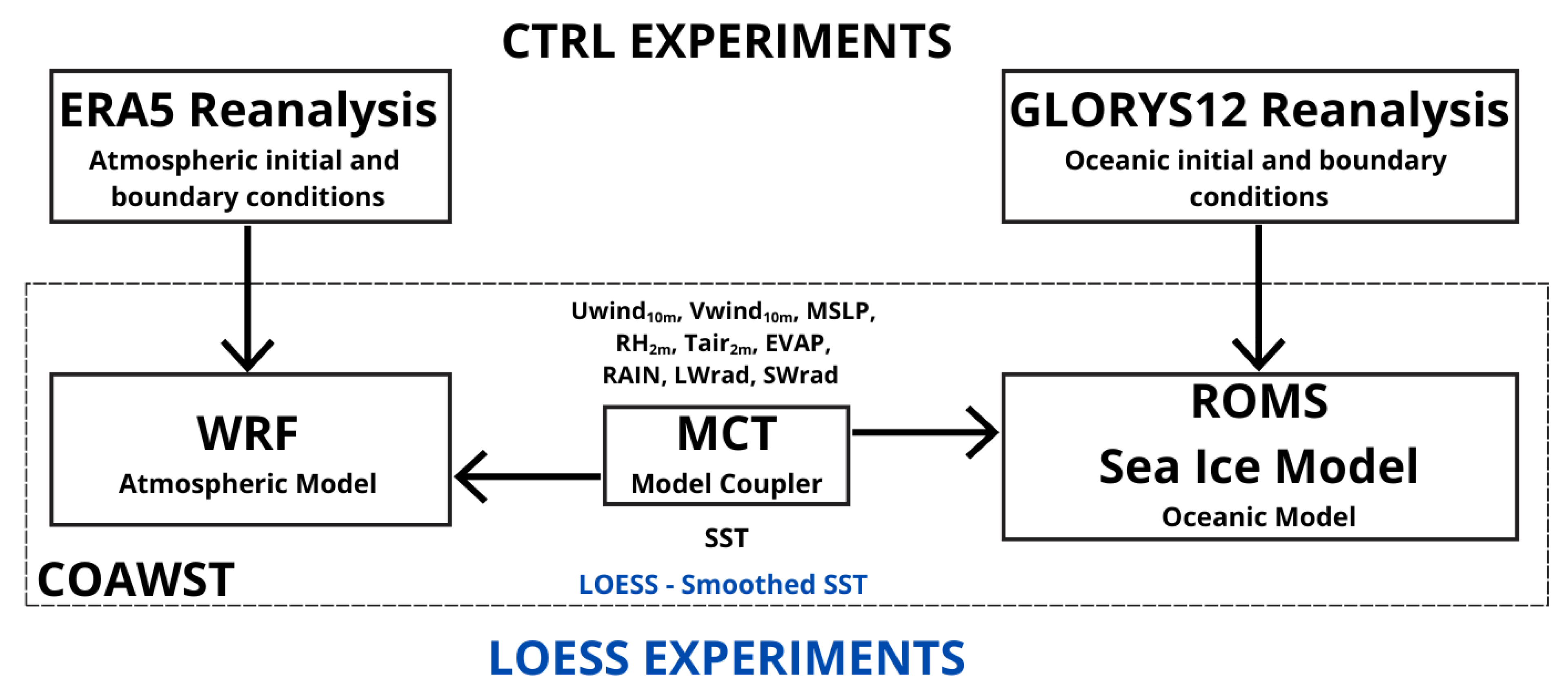
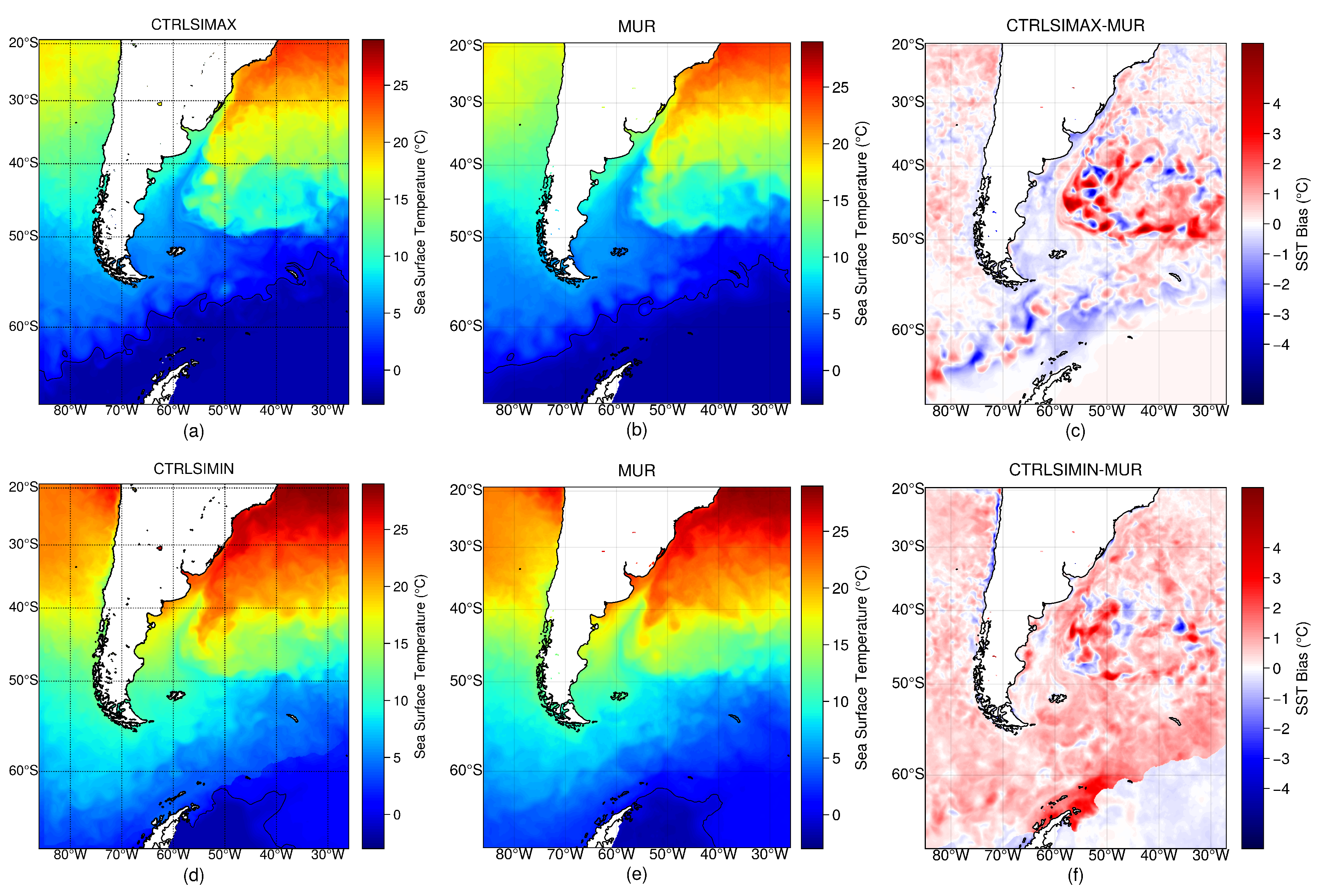


References
- Pezzi, L.; Souza, R.; Dourado, M.; Garcia, C.; Mata, M.; Silva-Dias, M. Ocean–atmosphere in situ observations at the Brazil–Malvinas Confluence region. Geophys. Res. Lett. 2005, 32, L24603. [Google Scholar] [CrossRef]
- O’Neill, L.W.; Esbensen, S.K.; Thum, N.; Samelson, R.M.; Chelton, D.B. Dynamical analysis of the boundary layer and surface wind responses to mesoscale SST perturbations. J. Clim. 2010, 23, 559–581. [Google Scholar] [CrossRef]
- Frenger, I.; Gruber, N.; Knutti, R.; Münnich, M. Imprint of Southern Ocean eddies on winds, clouds and rainfall. Nat. Geosci. 2013, 6, 608–612. [Google Scholar] [CrossRef]
- Villas Bôas, A.B.; Sato, O.T.; Chaigneau, A.; Castelão, G.P. The signature of mesoscale eddies on the air-sea turbulent heat fluxes in the South Atlantic Ocean. Geophys. Res. Lett. 2015, 42, 1856–1862. [Google Scholar] [CrossRef]
- Sugimoto, S.; Aono, K.; Fukui, S. Local atmospheric response to warm mesoscale ocean eddies in the Kuroshio–Oyashio confluence region. Sci. Rep. 2017, 7, 11871. [Google Scholar] [CrossRef] [PubMed]
- Desbiolles, F.; Meroni, A.N.; Renault, L.; Pasquero, C. Environmental Control of Wind Response to Sea Surface Temperature Patterns in Reanalysis Dataset. J. Clim. 2023, 36, 3881–3893. [Google Scholar] [CrossRef]
- Leyba, I.M.; Saraceno, M.; Solman, S.A. Air-sea heat fluxes associated to mesoscale eddies in the southwestern Atlantic Ocean and their dependence on different regional conditions. Clim. Dyn. 2017, 49, 2491–2501. [Google Scholar] [CrossRef]
- Pezzi, L.P.; Souza, R.B.; Santini, M.F.; Miller, A.J.; Carvalho, J.T.; Parise, C.K.; Quadro, M.F.; Rosa, E.B.; Justino, F.; Sutil, U.A.; et al. Oceanic eddy-induced modifications to air–sea heat and CO2 fluxes in the Brazil-Malvinas Confluence. Sci. Rep. 2021, 11, 10648. [Google Scholar] [CrossRef]
- Souza, R.; Pezzi, L.; Swart, S.; Oliveira, F.; Santini, M. Air-sea interactions over eddies in the Brazil-Malvinas Confluence. Remote Sens. 2021, 13, 1335. [Google Scholar] [CrossRef]
- Lentini, C.A.; Olson, D.B.; Podestá, G.P. Statistics of Brazil Current rings observed from AVHRR: 1993 to 1998. Geophys. Res. Lett. 2002, 29, 58–61. [Google Scholar] [CrossRef]
- Pezzi, L.P.; Souza, R.B.; Quadro, M.F. Uma revisão dos processos de interação oceano-atmosfera em regiões de intenso gradiente termal do oceano atlântico sul baseada em dados observacionais. Rev. Bras. Meteorol. 2016, 31, 428–453. [Google Scholar] [CrossRef]
- Cabrera, M.; Santini, M.; Lima, L.; Carvalho, J.; Rosa, E.; Rodrigues, C.; Pezzi, L. The Southwestern Atlantic Ocean mesoscale eddies: A review of their role in the air-sea interaction processes. J. Mar. Syst. 2022, 103785. [Google Scholar] [CrossRef]
- Wallace, J.M.; Mitchell, T.; Deser, C. The influence of sea-surface temperature on surface wind in the eastern equatorial Pacific: Seasonal and interannual variability. J. Clim. 1989, 2, 1492–1499. [Google Scholar] [CrossRef]
- Seo, H.; Bryan, F.O.; Kirtman, B.P.; Small, R.J.; O’Neill, L.W.; Frenger, I.; Wang, Z.; Chelton, D.B.; Minobe, S.; Ma, X.; et al. Ocean mesoscale and frontal-scale ocean–atmosphere interactions and influence on large-scale climate: A review. J. Clim. 2023, 36, 1981–2013. [Google Scholar] [CrossRef]
- Barreiro, M.; Chang, P.; Saravanan, R. Variability of the South Atlantic Convergence Zone simulated by an atmospheric general circulation model. J. Clim. 2002, 15, 745–763. [Google Scholar] [CrossRef]
- Peterson, R.G.; Stramma, L. Upper-level circulation in the South Atlantic Ocean. Prog. Oceanogr. 1991, 26, 1–73. [Google Scholar] [CrossRef]
- Orsi, A.H.; Whitworth, T.; Nowlin, W.D. On the meridional extent and fronts of the Antarctic Circumpolar Current. Deep Sea Res. Part I Oceanogr. Res. Pap. 1995, 42, 641–673. [Google Scholar] [CrossRef]
- Saraceno, M.; Provost, C. On eddy polarity distribution in the Southwestern Atlantic. Deep Sea Res. Part I Oceanogr. Res. Pap. 2012, 69, 62–69. [Google Scholar] [CrossRef]
- Dong, S.; Sprintall, J.; Gille, S.T. Location of the Antarctic Polar Front from AMSR-E satellite sea surface temperature measurements. J. Phys. Oceanogr. 2006, 36, 2075–2089. [Google Scholar] [CrossRef]
- Cavalieri, D.J.; Parkinson, C.L. Antarctic sea ice variability and trends, 1979–2006. J. Geophys. Res. Oceans 2008, 113, C07004. [Google Scholar] [CrossRef]
- Putrasahan, D.A.; Miller, A.J.; Seo, H. Regional coupled ocean–atmosphere downscaling in the southeast Pacific: Impacts on upwelling, mesoscale air–sea fluxes, and ocean eddies. Ocean Dyn. 2013, 63, 463–488. [Google Scholar] [CrossRef]
- Putrasahan, D.A.; Miller, A.J.; Seo, H. Isolating mesoscale coupled ocean–atmosphere interactions in the Kuroshio Extension region. Dyn. Atmos. Oceans 2013, 63, 60–78. [Google Scholar] [CrossRef]
- Kilpatrick, T.; Schneider, N.; Qiu, B. Boundary layer convergence induced by strong winds across a midlatitude SST front. J. Clim. 2014, 27, 1698–1718. [Google Scholar] [CrossRef]
- Oerder, V.; Colas, F.; Echevin, V.; Masson, S.; Lemarié, F. Impacts of the mesoscale ocean–atmosphere coupling on the Peru–Chile ocean dynamics: The current-induced wind stress modulation. J. Geophys. Res. Oceans 2018, 123, 812–833. [Google Scholar] [CrossRef]
- Renault, L.; Masson, S.; Oerder, V.; Jullien, S.; Colas, F. Disentangling the mesoscale ocean–atmosphere interactions. J. Geophys. Res. Oceans 2019, 124, 2164–2178. [Google Scholar] [CrossRef]
- Cabrera, M.J.; Pezzi, L.P.; Santini, M.F.; Sutil, U.A.; Aravéquia, J.A.; de Camargo, R. Stability mechanisms and air temperature advection on the marine atmospheric boundary layer modulation at the Southwestern Atlantic Ocean. Q. J. R. Meteorol. Soc. 2023, 149, 2176–2195. [Google Scholar] [CrossRef]
- Warner, J.C.; Armstrong, B.; He, R.; Zambon, J.B. Development of a coupled ocean–atmosphere–wave–sediment transport (COAWST) modeling system. Ocean Model. 2010, 35, 230–244. [Google Scholar] [CrossRef]
- Skamarock, W.C.; Klemp, J.B.; Dudhia, J.; Gill, D.O.; Barker, D.M.; Duda, M.G.; Huang, X.-Y.; Wang, W.; Powers, J.G. A Description of the Advanced Research WRF Version 4. 2019. Available online: https://figshare.com/articles/journal_contribution/A_Description_of_the_Advanced_Research_WRF_Version_4/7369994 (accessed on 1 June 2023).
- Shchepetkin, A.F.; McWilliams, J.C. The Regional Oceanic Modeling System (ROMS): A split-explicit, free-surface, topography-following-coordinate oceanic model. Ocean Model. 2005, 9, 347–404. [Google Scholar] [CrossRef]
- Haidvogel, D.B.; Arango, H.G.; Hedstrom, K.; Beckmann, A.; Malanotte-Rizzoli, P.; Shchepetkin, A.F. Ocean forecasting in terrain-following coordinates: Formulation and skill assessment of the Regional Ocean Modeling System. J. Comput. Phys. 2008, 227, 3595–3624. [Google Scholar] [CrossRef]
- Shchepetkin, A.F.; McWilliams, J.C. Correction and commentary for “Ocean forecasting in terrain-following coordinates: Formulation and skill assessment of the regional ocean modeling system” by Haidvogel et al., J. Comput. Phys. 227, pp. 3595–3624. J. Comput. Phys. 2009, 228, 8985–9000. [Google Scholar] [CrossRef]
- Budgell, W. Numerical simulation of ice–ocean variability in the Barents Sea region. Ocean Dyn. 2005, 55, 370–387. [Google Scholar] [CrossRef]
- Jacob, R.; Larson, J.; Ong, E. M×N communication and parallel interpolation in Community Climate System Model Version 3 using the Model Coupling Toolkit. Int. J. High Perform. Comput. Appl. 2005, 19, 293–307. [Google Scholar] [CrossRef]
- Larson, J.; Jacob, R.; Ong, E. The Model Coupling Toolkit: A new Fortran90 toolkit for building multiphysics parallel coupled models. Int. J. High Perform. Comput. Appl. 2005, 19, 277–292. [Google Scholar] [CrossRef]
- Hersbach, H.; Bell, B.; Berrisford, P.; Hirahara, S.; Horányi, A.; Muñoz-Sabater, J.; Nicolas, J.; Peubey, C.; Radu, R.; Schepers, D.; et al. The ERA5 global reanalysis. Q. J. R. Meteorol. Soc. 2020, 146, 1999–2049. [Google Scholar] [CrossRef]
- Lellouche, J.M.; Greiner, E.; Le Galloudec, O.; Garric, G.; Regnier, C.; Drevillon, M.; Hamon, M.; Reffray, G.; Benkiran, M.; Testut, C.; et al. The Copernicus Global 1/12° Oceanic and Sea Ice GLORYS12 Reanalysis. Front. Earth Sci. 2021, 9, 698876. [Google Scholar] [CrossRef]
- Pezzi, L.P.; Quadro, M.F.L.; Souza, E.B.; Miller, A.J.; Rao, V.B.; Rosa, E.B.; Santini, M.F.; Bender, A.; Souza, R.B.; Cabrera, M.J.; et al. Oceanic SACZ produces an abnormally wet 2021/2022 rainy season in South America. Sci. Rep. 2023, 13, 1455. [Google Scholar] [CrossRef] [PubMed]
- Hedstrom, K. Technical Manual for a Coupled Sea-Ice/Ocean Circulation Model (Version 5); BOEM: Anchorage, AK, USA, 2018; p. 182. [Google Scholar]
- Marchesiello, P.; McWilliams, J.C.; Shchepetkin, A. Open boundary conditions for long-term integration of regional oceanic models. Ocean Model. 2001, 3, 1–20. [Google Scholar] [CrossRef]
- Oddo, P.; Pinardi, N. Lateral open boundary conditions for nested limited area models: A scale selective approach. Ocean Model. 2008, 20, 134–156. [Google Scholar] [CrossRef]
- Chin, T.M.; Vazquez-Cuervo, J.; Armstrong, E.M. A multi-scale high-resolution analysis of global sea surface temperature. Remote Sens. Environ. 2017, 200, 154–169. [Google Scholar] [CrossRef]
- EUMETSAT Ocean and Sea Ice Satellite Application Facility (OSI SAF). Sea Ice Concentration, High Latitude Processing Center. 2023. Available online: https://osisaf-hl.met.no (accessed on 1 January 2023).
- Kubota, T.; Aonashi, K.; Ushio, T.; Shige, S.; Takayabu, Y.N.; Kachi, M.; Arai, Y.; Tashima, T.; Masaki, T.; Kawamoto, N.; et al. Global Satellite Mapping of Precipitation (GSMaP) products in the GPM era. In Satellite Precipitation Measurement; Springer: Cham, Switzerland, 2020. [Google Scholar] [CrossRef]
- Cleveland, W.S.; Devlin, S.J. Locally weighted regression: An approach to regression analysis by local fitting. J. Am. Stat. Assoc. 1988, 83, 596–610. [Google Scholar] [CrossRef]
- Schlax, M.G.; Chelton, D.B.; Freilich, M.H. Sampling errors in wind fields constructed from single and tandem scatterometer datasets. J. Atmos. Ocean. Technol. 2001, 18, 1014–1036. [Google Scholar] [CrossRef]
- Perlin, N.; de Szoeke, S.P.; Chelton, D.B.; Samelson, R.M.; Skyllingstad, E.D.; O’Neill, L.W. Modeling the atmospheric boundary layer wind response to mesoscale sea surface temperature perturbations. Mon. Weather Rev. 2014, 142, 4284–4307. [Google Scholar] [CrossRef]
- Seo, H.; Miller, A.J.; Norris, J.R. Eddy–wind interaction in the California Current System: Dynamics and impacts. J. Phys. Oceanogr. 2016, 46, 439–459. [Google Scholar] [CrossRef]
- Cui, C.; Zhang, R.-H.; Wang, H.; Wei, Y. Representing surface wind stress response to mesoscale SST perturbations in western coast of South America using Tikhonov regularization method. J. Oceanol. Limnol. 2020, 38, 679–694. [Google Scholar] [CrossRef]
- Cui, C.; Xu, L. The Mesoscale SST–Wind Coupling Characteristics in the Yellow Sea and East China Sea Based on Satellite Data and Their Feedback Effects on the Ocean. J. Mar. Sci. Eng. 2024, 12, 1743. [Google Scholar] [CrossRef]
- Santini, M.; Souza, R.; Pezzi, L.; Swart, S. Observations of air–sea heat fluxes in the southwestern Atlantic under high-frequency ocean and atmospheric perturbations. Q. J. R. Meteorol. Soc. 2020, 146, 4226–4251. [Google Scholar] [CrossRef]
- Strub, P.T.; James, C.; Combes, V.; Matano, R.P.; Piola, A.R.; Palma, E.D.; Saraceno, M.; Guerrero, R.A.; Fenco, H.; Ruiz-Etcheverry, L.A. Altimeter-derived seasonal circulation on the southwest Atlantic shelf: 27–43° S. J. Geophys. Res. Oceans 2015, 120, 3391–3418. [Google Scholar] [CrossRef] [PubMed]
- Artana, C.I.; Provost, C.; Lellouche, J.M.; Rio, M.H.; Ferrari, R.; Sennéchael, N. The Malvinas Current at the Confluence with the Brazil Current: Inferences from 25 Years of Mercator Ocean Reanalysis. J. Geophys. Res. Oceans 2019, 124, 7178–7200. [Google Scholar] [CrossRef]
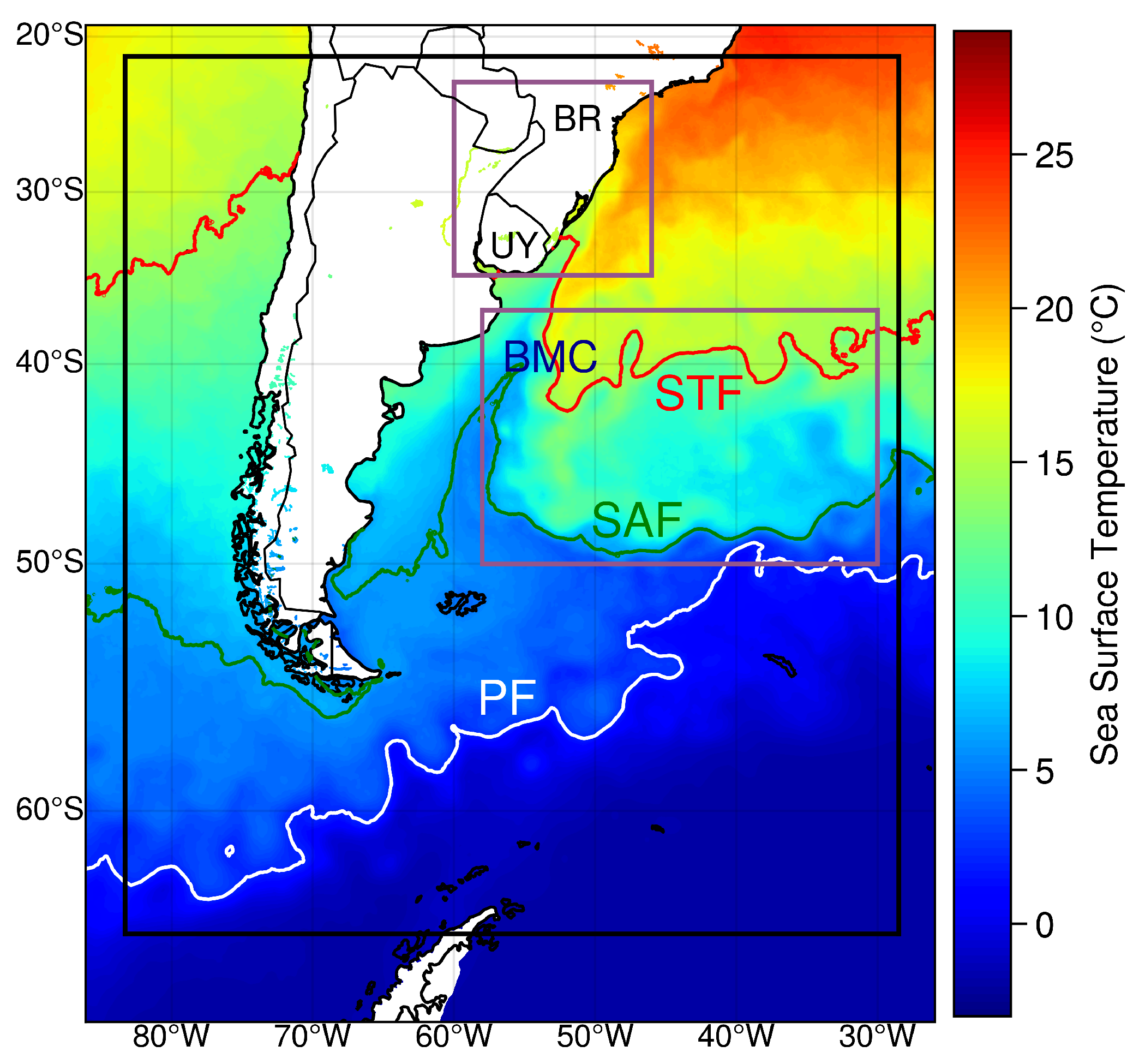
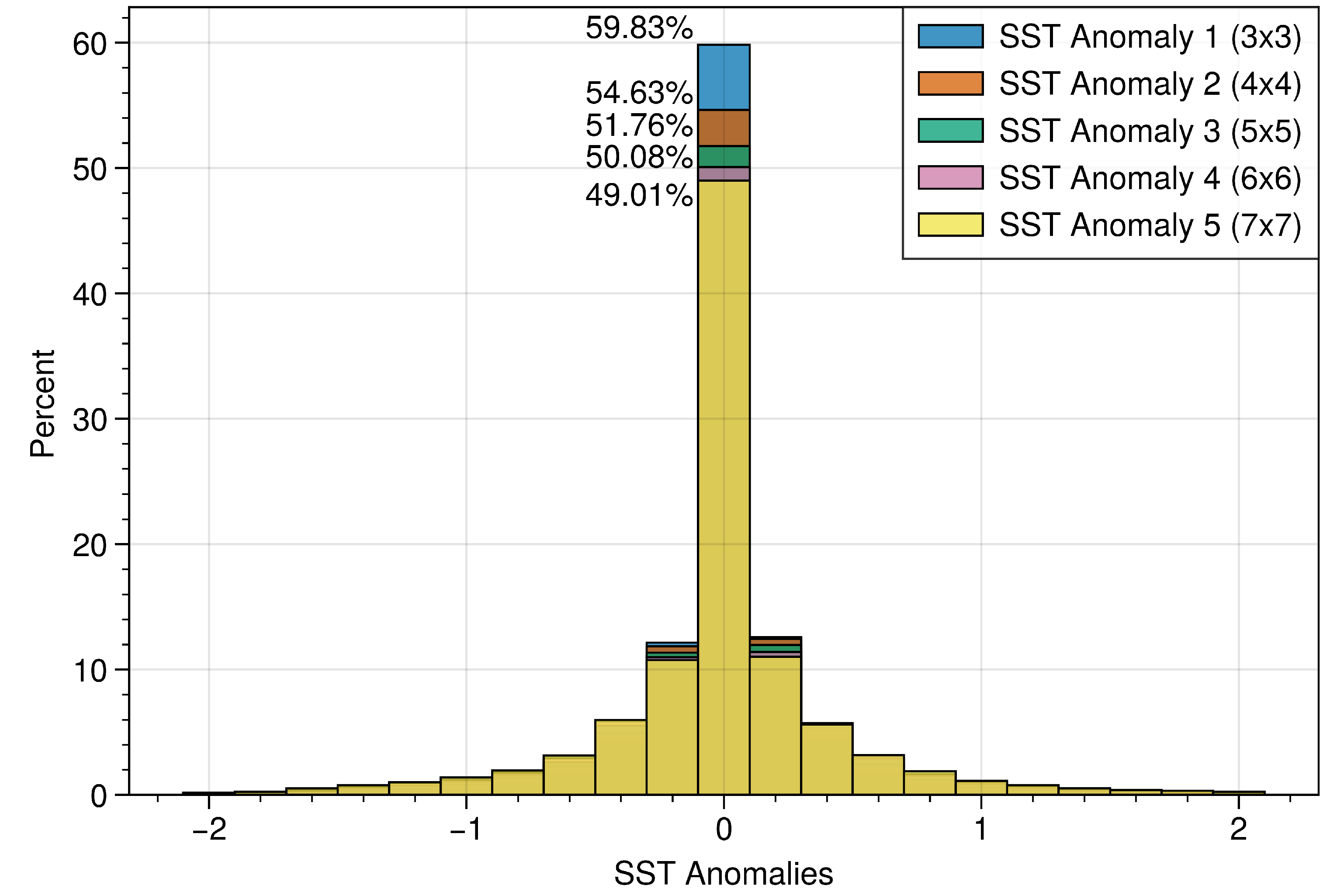
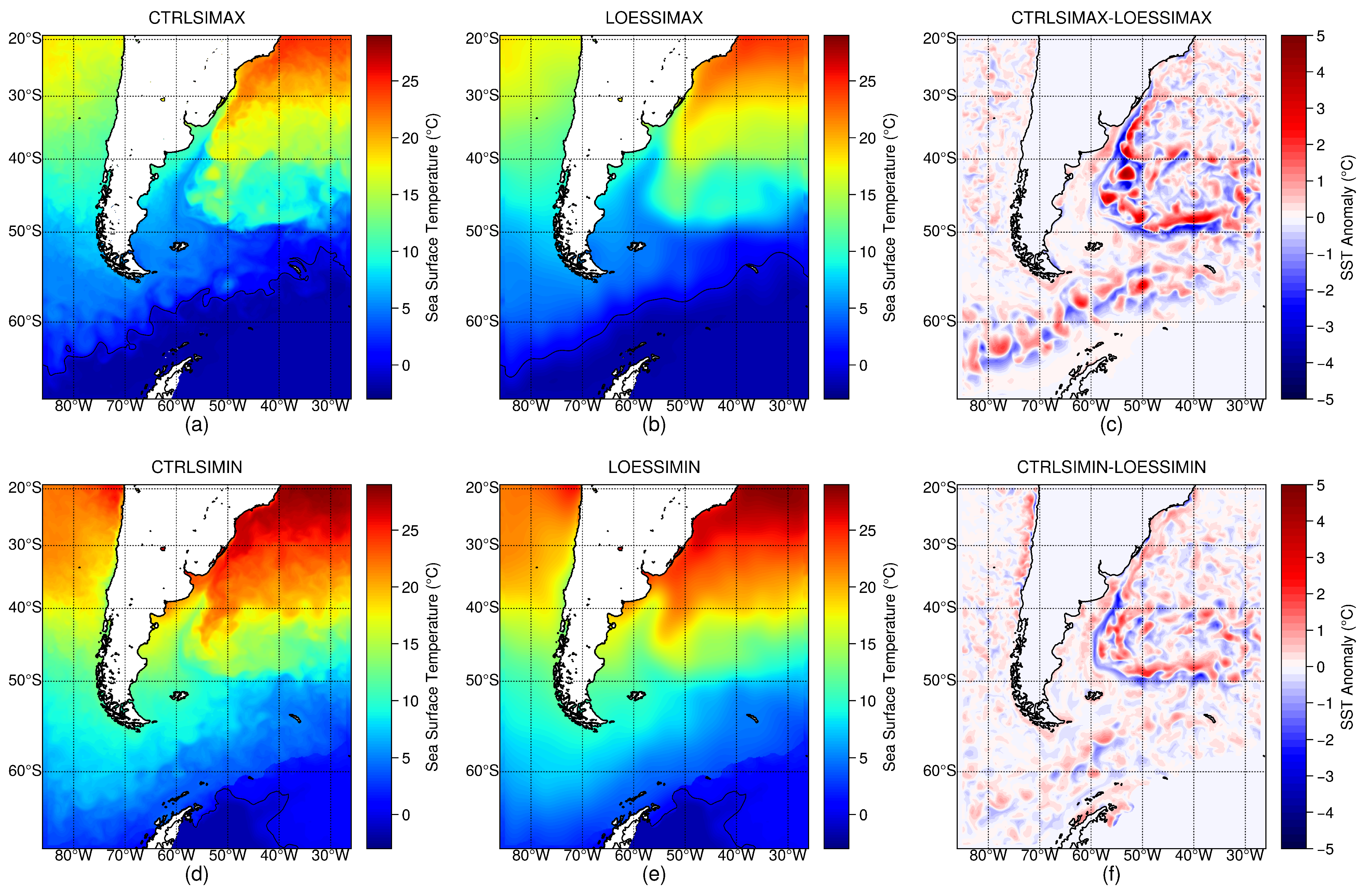

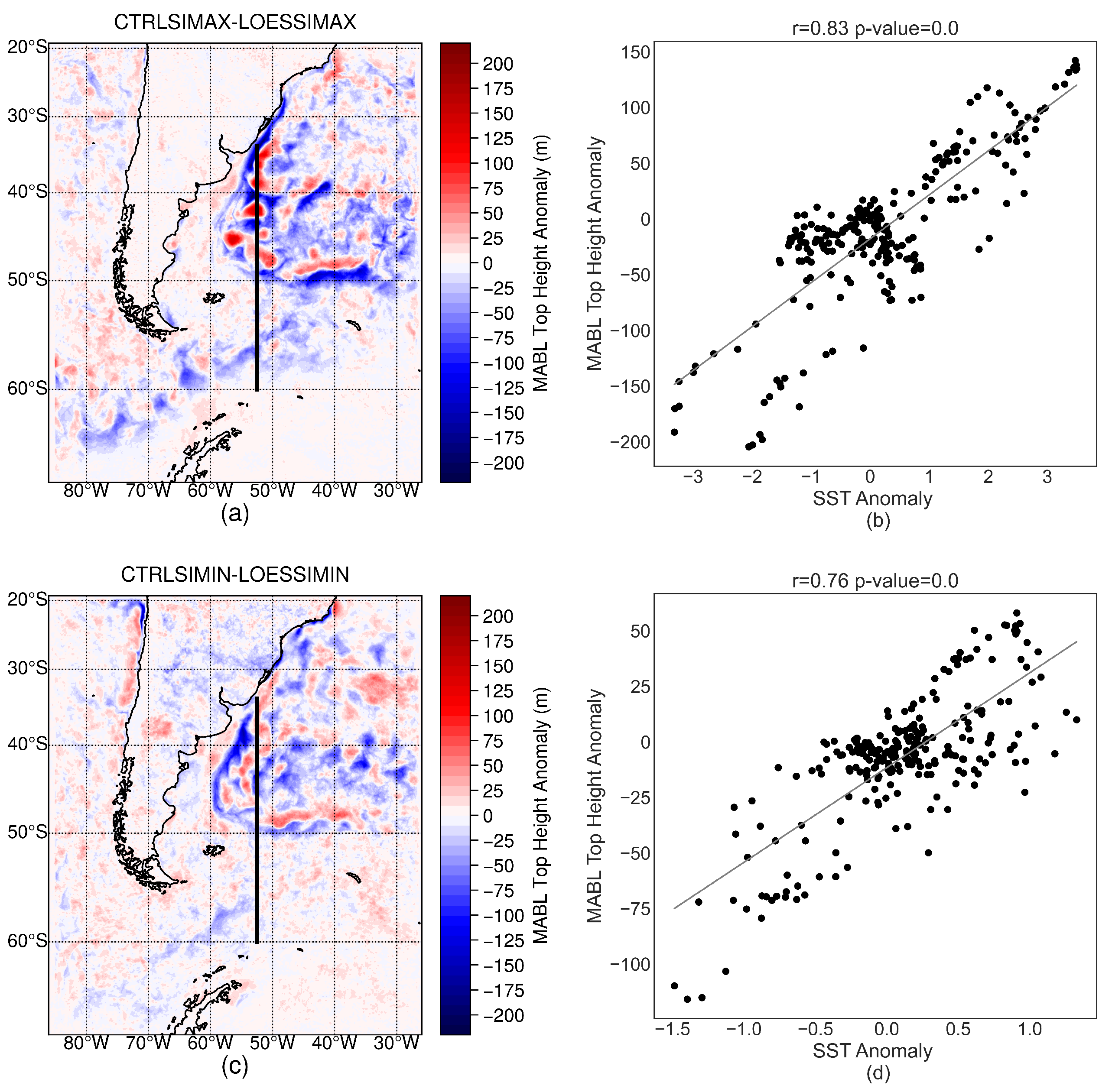
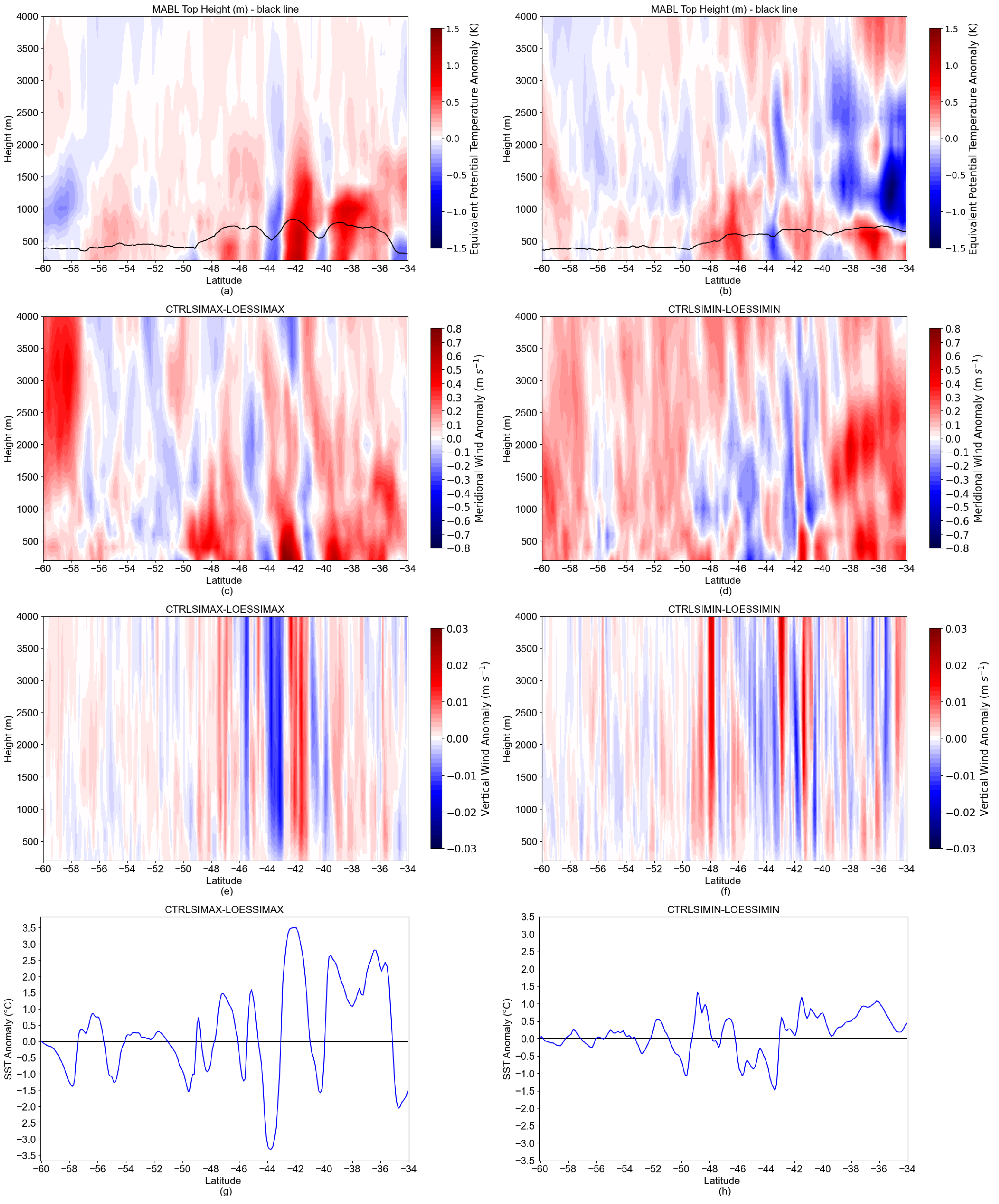
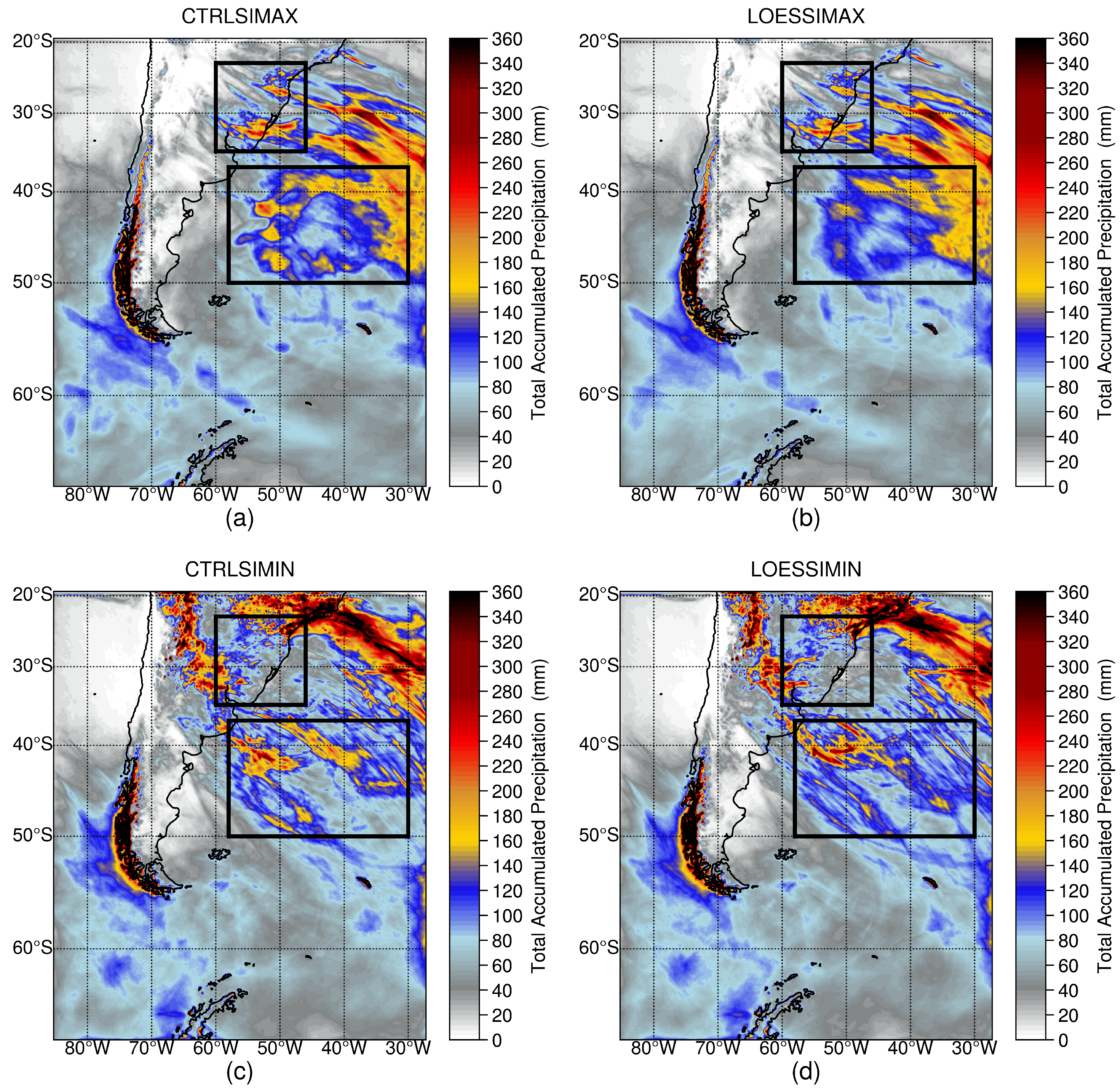
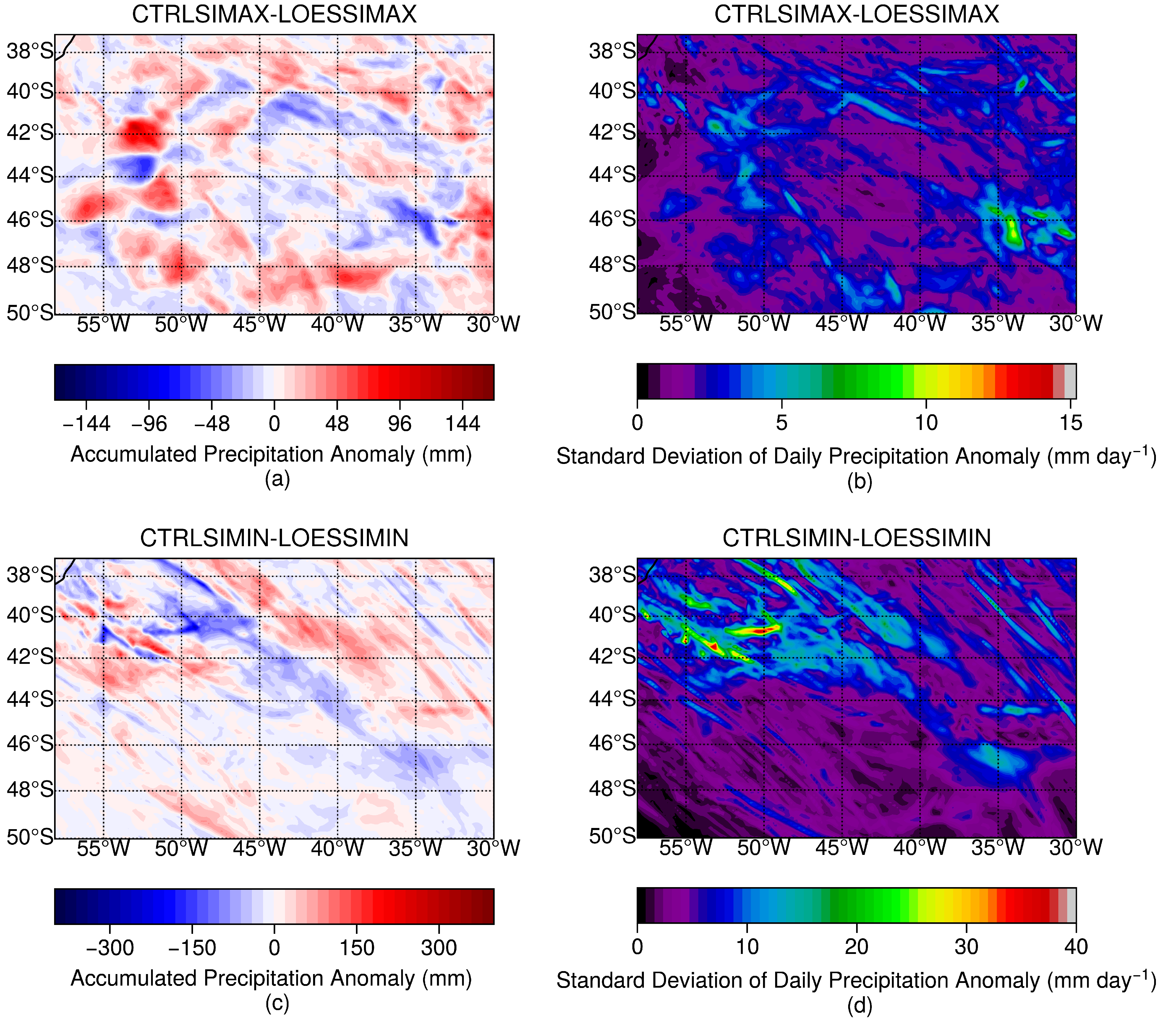

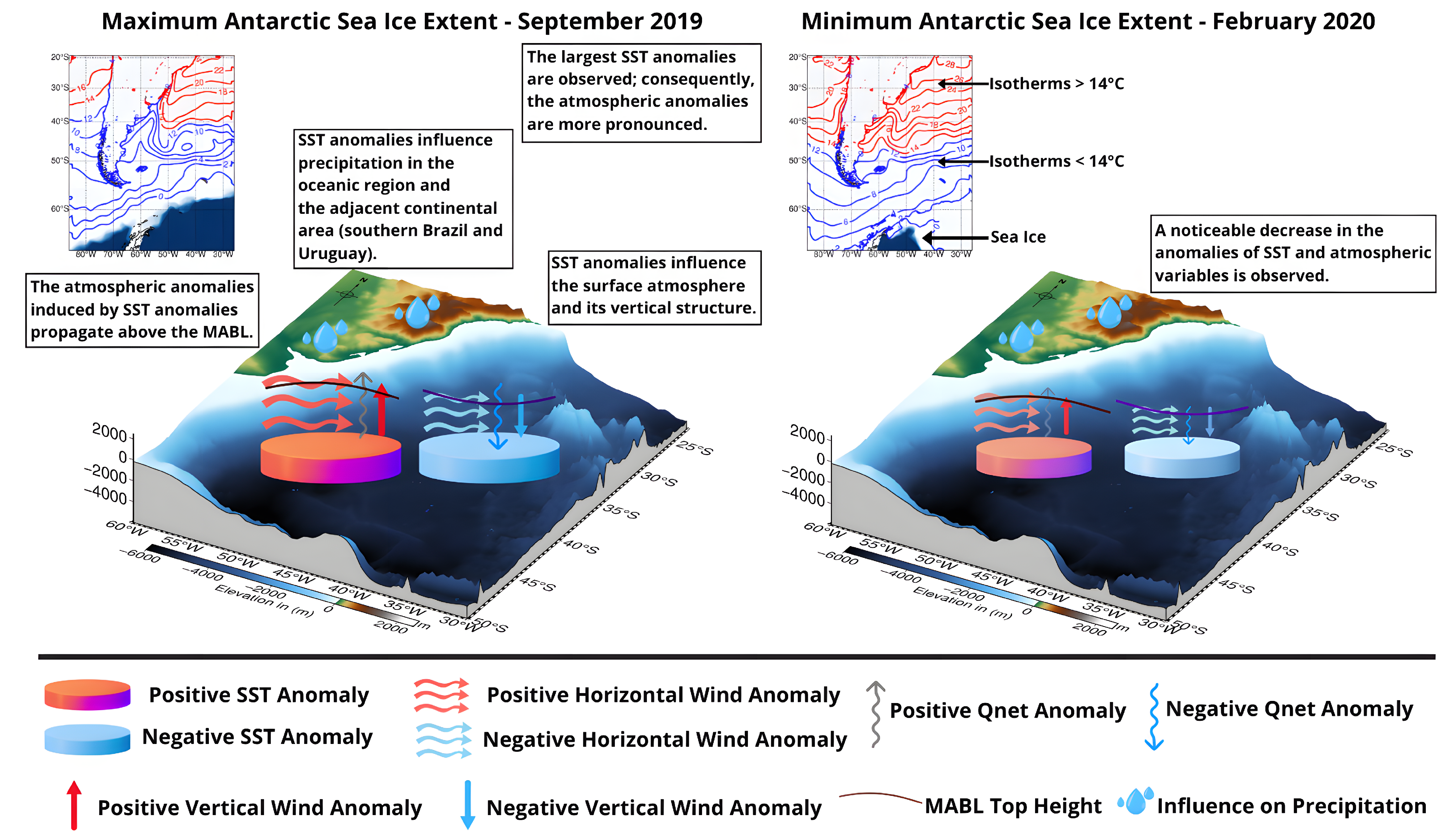
| Numerical Experiment | Analyzed Period | LOESS Filter |
|---|---|---|
| CTRLSIMAX | September 2019 | No |
| LOESSIMAX | September 2019 | Yes |
| CTRLSIMIN | February 2020 | No |
| LOESSIMIN | February 2020 | Yes |
Disclaimer/Publisher’s Note: The statements, opinions and data contained in all publications are solely those of the individual author(s) and contributor(s) and not of MDPI and/or the editor(s). MDPI and/or the editor(s) disclaim responsibility for any injury to people or property resulting from any ideas, methods, instructions or products referred to in the content. |
© 2025 by the authors. Licensee MDPI, Basel, Switzerland. This article is an open access article distributed under the terms and conditions of the Creative Commons Attribution (CC BY) license (https://creativecommons.org/licenses/by/4.0/).
Share and Cite
Cabrera, M.; Pezzi, L.; Santini, M.; Mendes, C. Quantifying the Influence of Sea Surface Temperature Anomalies on the Atmosphere and Precipitation in the Southwestern Atlantic Ocean and Southeastern South America. Atmosphere 2025, 16, 887. https://doi.org/10.3390/atmos16070887
Cabrera M, Pezzi L, Santini M, Mendes C. Quantifying the Influence of Sea Surface Temperature Anomalies on the Atmosphere and Precipitation in the Southwestern Atlantic Ocean and Southeastern South America. Atmosphere. 2025; 16(7):887. https://doi.org/10.3390/atmos16070887
Chicago/Turabian StyleCabrera, Mylene, Luciano Pezzi, Marcelo Santini, and Celso Mendes. 2025. "Quantifying the Influence of Sea Surface Temperature Anomalies on the Atmosphere and Precipitation in the Southwestern Atlantic Ocean and Southeastern South America" Atmosphere 16, no. 7: 887. https://doi.org/10.3390/atmos16070887
APA StyleCabrera, M., Pezzi, L., Santini, M., & Mendes, C. (2025). Quantifying the Influence of Sea Surface Temperature Anomalies on the Atmosphere and Precipitation in the Southwestern Atlantic Ocean and Southeastern South America. Atmosphere, 16(7), 887. https://doi.org/10.3390/atmos16070887








